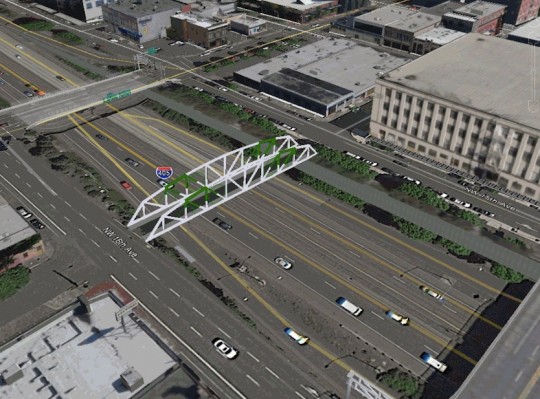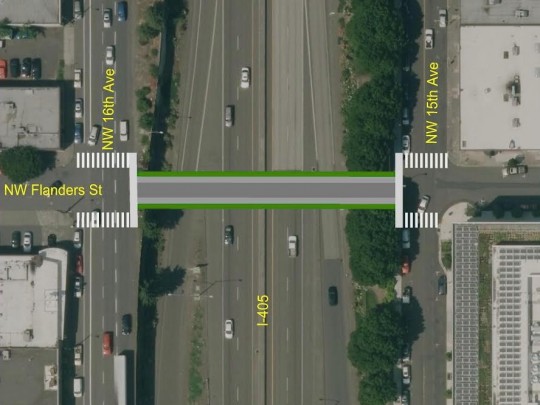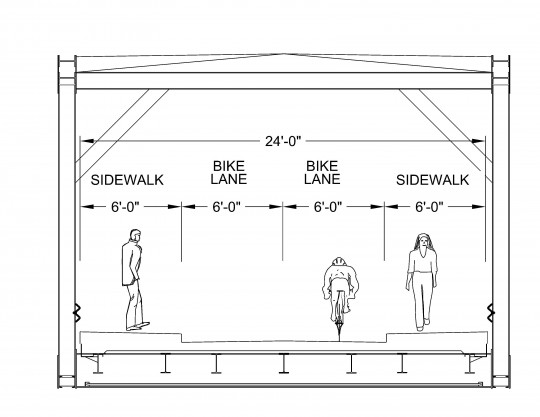At long last the City of Portland has a clear and solid plan for building a biking and walking bridge over I-405 at Northwest Flander St. Now all they need is $3 million from the Oregon Department of Transportation to build it.
As we shared last month, the transportation bureau has submitted applications to Connect Oregon, a state lottery-backed funding program that aims to fund transportation projects that are not on highway right-of-way (and therefore can’t be paid for with gas tax revenues).
Currently pedestrians and bicyclists crossing I-405 must negotiate high-stress roadway overcrossings that include freeway interchange on and off ramps, high traffic volumes and speeds, and poor pedestrian and bicycle connectivity.
— from PBOT grant application
According to the grant application which we obtained through a public records request PBOT estimates the total cost of the Flanders Crossing Active Transportation Bridge to be $6 million. If they receive half of that from ODOT, they’ll pay for the other half with System Development Charges.
Along with the bridge, PBOT will finally build the Flanders Street Neighborhood Greenway which will create a low-stress bicycling route from NW 24th Avenue at the base of the West Hills all the way to the lower path of the Steel Bridge and the Willamette River (PBOT has also applied for grant funding for a new bikeway crossing of NW Naito at Flanders, we’ll share more details on that next week). The new bridge would also come with new signalized crossings on NW 16th and 14th.
I-405 has long been known as a barrier to this key east-west route because of a lack of safe crossings for people on bikes and on foot. The two nearby streets — Everett and Glisan — both lack sidewalks on one side and require people to cross freeway on and off-ramps. “These high-stress crossings are enough to dissuade large segments of the population,” the city’s application states, “from choosing to walk or bike to work or other destinations in the Central City despite such close proximity.”
Advertisement
A biking and walking-only bridge over I-405 has been in the city’s plan for nearly a decade. It was mentioned in Portland’s Transportation System Plan in 2007. The Flanders Bikeway is classified in the Portland Bicyle Plan for 2030 as a Major City Bikeway.
The bridge design itself isn’t finalized, but PBOT spokesman Dylan Rivera says the leading candidate right now is a steel structure that would offer 24-feet of right-of-way.
The current cross-section under consideration would split that space up between two six-foot sidewalks and two six-foot bike lanes. Rivera said PBOT feels 12 feet in each direction will be adequate for the expected daily capacity of the bridge. According to traffic demand models, PBOT expects over 9,000 bike and walk trips over the bridge by 2035. (By way of comparison, the Hawthorne Bridge has 10-foot wide shared bike/walkways and handles about 8,200 trips per day.)
The model projects 9,135 users in 2035. That is a figure for total users: bike and pedestrian. An educated guess would suggest 2/3 of those trips would be by bike, so roughly 6,000 bike trips in 2035. For comparison purposes, you might think of the peak summer counts on the Hawthorne at about 8,000, and the peak summer counts for the Steel and Broadway, which are currently about 4,500.
One thing that will impact usage of this bridge are the 17 large employers in the immediate area and the 21,292 people they employ.
There’s one key aspect of this new Flanders Bridge that PBOT hopes makes it even more competitive in the grant process: They’ve designed it to be an emergency lifeline route in the event of a major earthquake or other emergency. PBOT engineers say it would be designed in such a way to be, “operational following the most probabale earthquake to occur within 500 years.”
Bolstering the city’s case for this project is resounding support from advocates, nearby residents and businesses. Letters of support have been written from: PBOT’s Bicycle and Pedestrian Advisory Committees, Bicyle Transportation Alliance, NW District Association, Pearl District Neighborhood Association, Old Town Chinatown Community Association, Legacy Good Samaritan Medical Center, Nob Hill Business Association, Pearl District Business Association, Pacific NW College of Art, and Vestas.
If this all sounds a bit familiar, it’s because a bridge at Flanders was first proposed by PBOT back in 2006. Former Mayor Sam Adams wanted to recycle the old Sauvie Island Bridge and place it over I-405. The project had broad support, but also detractors who claimed it wasn’t equitable to invest in the central city while east Portland still lacked basic infrastructure. The idea was ultimately shelved in 2008.
While the politics are likely to be easier this time around, the grant award is by no means a done deal. Competition is fierce as this project will compete against port, rail, marine, and other biking and walking projects around the state. ODOT received over $91 million in requests and they have only $45 million to hand out. The winners will be chosen by the Oregon Transportation Commission and announced in August 2016. Rivera said PBOT estimates if funding comes through the new bridge could open in 2019.
“It would be transformative for Northwest Portland,” he added.
This is one of five bikeway projects PBOT has applied for. We’ll take a closer look at the others next week.
— Jonathan Maus, (503) 706-8804 – jonathan@bikeportland.org




